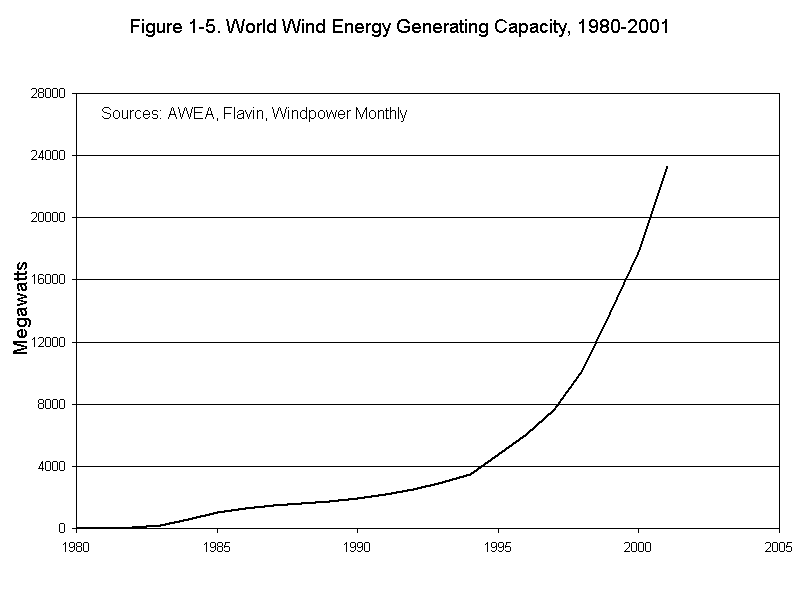Lester R. Brown, Janet Larsen, and Bernie Fischlowitz-Roberts
Part 1. Facing the Climate Challenge: Building the Wind-Hydrogen Economy
For many years it appeared that wind would be a cornerstone of the new energy economy, but it now appears that it could become the centerpiece. Between 1995 and 2001, world wind electric generation multiplied nearly fivefold. (See Figure 1–5.) The generating capacity of 24,000 megawatts at the end of 2001 was sufficient to meet the residential needs of 24 million people at industrial-country consumption levels, a number equal to the combined populations of Denmark, Finland, Norway, and Sweden. 24
Wind is abundant, cheap, inexhaustible, and clean—four attributes that make it unique. By any yardstick, it is an abundant resource. In the United States, for example, a national wind resource inventory by the Department of Energy reports that the United States is richly endowed with wind energy. The Great Plains, sometimes referred to as the Saudi Arabia of wind energy, could easily supply twice as much electricity as the United States now uses. The United States is not the only country with a wealth of wind. China could double its current electricity generation from wind alone. Europe has enough readily accessible offshore wind energy to satisfy its demand for electricity. 25
Over the last 15 years, the cost of generating electricity from wind has fallen dramatically, dropping from 38¢ a kilowatt-hour to 4¢ or less at prime wind sites today. Indeed, some recent long-term wind electricity supply contracts have been signed at 3¢ per kilowatt-hour. Wind-generated electricity is now competitive with that generated from other sources, even without including the costs of climate disruption associated with producing electricity from fossil fuels. 26
Once cheap electricity from wind is available, it can be used to electrolyze water, producing hydrogen. Hydrogen is a way of both storing and efficiently transporting wind energy. Hydrogen is the fuel of choice for the new fuel-cell vehicles that every major automobile manufacturer is working on. Parallel technological advances over the last decade in the design of wind turbines and the evolution of fuel-cell engines have set the stage for a restructuring of the world energy economy. In the United States, for example, farmers and ranchers, who own most of the wind rights, could one day not only meet most of the country’s electricity needs but also supply much of the fuel used in automobiles.
The hydrogen era is beginning to unfold. Both Honda and DaimlerChrysler plan to be on the market with fuel-cell automobiles powered by hydrogen in 2003. Ford expects to be in the market in 2004 with fuel-cell vehicles that run on compressed hydrogen. It will initially concentrate its marketing on fleets of cars that can easily be fueled from a central fueling station. 27
The Icelandic government is working with a consortium of companies led by Shell and DaimlerChrysler to become the world’s first hydrogen-powered economy. The first phase of this program begins in 2003 with the conversion of 3 of Reykjavik’s 80 buses from internal combustion to fuel-cell engines. Shell will open its first hydrogen station in Iceland to supply the buses with fuel. 28
Singapore, anticipating the arrival of fuel-cell-powered automobiles in 2003, has signed a letter of intent with BP to build several hydrogen stations. Air pollution concerns apparently are driving this shift to the non-polluting fuel-cell engine. 29
Farmers and ranchers are beginning to mobilize in support of developing wind energy. Local political leaders are starting to understand the economic benefits for rural communities of developing their wind resources. In contrast to fossil-fuel power plants, the income from wind-generated electricity tends to stay in the community.
Among the countries moving rapidly to develop their wind resources are Germany, Denmark, Spain, and the United States. Denmark now gets more than 15 percent of its electricity from wind. In Schleswig-Holstein, the northernmost state in Germany, the figure is 28 percent; in the state of Meckenburg-Vorponnen, it is 21 percent. In Navarra, a northern industrial province in Spain, 22 percent of the electricity comes from wind. Wind-generated electricity in California is sufficient to meet the residential needs of San Francisco. 30
Once a country’s wind-generating capacity reaches 100 megawatts, wind resource development tends to accelerate, acquiring a momentum of its own. At this point, countries appear to have the engineering experience, the financial structures, and the professional expertise in place to develop this vast but largely untapped resource. Some 16 countries, home to half the world’s people, are now in this group.
In the wind-hydrogen economy, wind turbines will replace smokestacks. Hydrogen generators will replace oil refineries. Fuel cells will replace internal combustion engines. Fuel cells run on hydrogen do not produce any pollutants nor do they make any noise. Quiet cities with clean air will replace noisy, polluted cities.
Among the countries setting ambitious wind development goals are Germany, Spain, the United Kingdom, France, Argentina, India, China, Brazil, and the United States. A 3,000-megawatt wind farm in the early planning stages in South Dakota is one of the largest energy projects being contemplated anywhere. Some wind-rich countries could become hydrogen exporters in the new energy economy: Canada, which is richly endowed with wind but sparsely populated, and Argentina, with world-class wind resources in Patagonia, could become leading hydrogen exporters. Both countries could generate vast quantities of hydrogen, supplying it in perpetuity, to more densely populated countries with less favorable wind/population ratios. 31
In the northwestern United States, where hydropower is already well established, cities such as Salem, Oregon, are now moving to get the rest of their electricity from wind, making them entirely independent of fossil fuels for electricity. The shift from a fossil-fuel-based economy to a renewable-energy-based one is under way. The challenge now is to accelerate that transition before climate change spirals out of control. 32

*Data and additional resources have been omitted from this mobile version of our website to ensure the most optimal experience. To view this page with its entire information, please visit the full website.